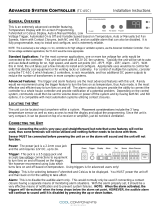
Voltage
Minimum Waiting Time
4 min. 15 min. 20 min. 30 min. 40 min.
200 - 240 V 1.1 - 3.7 kW 5.5 - 45 kW
380 - 480 V 1.1 - 7.5 kW 11 - 90 kW 110 -200 kW 250 - 450 kW
525 - 600 V 1.1 - 7.5 kW 110 - 250 kW 315 - 560 kW
525 - 690 V 45 - 90 kW 110 - 250 kW 315 - 560 kW 630 - 1200 kW
Be aware that there may be high voltage on the DC link even when the LEDs are turned off.
1.2.1 Introduction
The Siemens Floor Level Network (FLN) is a master/ slave control network for serial communication with various control devices. The FLN controller is
RS-485 compatible, half duplex, with an operating rate of 4800 or 9600 baud. Recommended wiring is shielded, twisted pair. The FLN software protocol
is designed to be general in nature to accommodate any unique properties of each device type. The node address system allows up to 96 devices to be
used on any one system.
The VLT is a programmable frequency converter, which controls the operation of 3-phase, standard induction electrical motors in the HVAC industry.
The VLT control card has FLN communication protocol software built-in. The drive uses optical isolation for fault tolerance and noise immunity.
The FLN communicates directly with the VLT drive via the RS-485 serial interface bus. In addition to being able to control the drive, most drive configuration
and control parameters can be reviewed and changed through the FLN. Also, the operational status of the drive can be read and monitored through the
bus. Diagnostic and operational information stored in the VLT is easily available, such as kWh of energy used, total operation hours, drive status, motor
speed, and many other useful items which can be accessed and monitored through the FLN.
The FLN is designed to communicate with any controller node that supports the interfaces defined in this document.
1.2.2 About this Manual
The documentation in this manual provides comprehensive information on the connection, programming, and startup of the VLT for use with the FLN. It
is intended as both an instruction and reference manual. Functions and features of the VLT frequency converter are also briefly reviewed to serve as a
guideline to optimize your communication system. Read this manual before programming since important information is provided in each section. For
detailed information on using the VLT, see the Operating Instructions.
1.2.3 Assumptions
This manual assumes that the controller node supports the interfaces in this document and that all the requirements and limitations stipulated in the
controller node and the VLT are strictly observed. It is assumed that the user understands the general capabilities and limitation of the controller node
and the VLT Frequency Converter.
1.2.4 Available literature for
- Operating Instructions MG.11.Ax.yy provide the neccessary information for getting the frequency converter up and running.
- Design Guide MG.11.Bx.yy entails all technical information about the frequency converter and customer design and applications.
- Programming Guide MG.11.Cx.yy provides information on how to programme and includes complete parameter descriptions.
- Mounting Instruction, Analog I/O Option MCB109, MI.38.Bx.yy
-
PC-based Configuration Tool MCT 10, MG.10.Ax.yy enables the user to configure the frequency converter from a Windows
™
based PC environ-
ment.
-
VLT
®
Energy Box software at
www.danfoss.com/BusinessAreas/DrivesSolutions
then choose PC Software Download
-
VLT
®
Drive Applications, MG.11.Tx.yy
- Operating Instructions BACnet, MG.11.Dx.yy
- Operating Instructions Profibus, MG.33.Cx.yy.
- Operating Instructions Device Net, MG.33.Dx.yy
- Operating Instructions LonWorks, MG.11.Ex.yy
1 Introduction VLT
®
HVAC Drive FLN Operating Instructions
4
MG.11.Z1.02 - VLT is a registered Danfoss trademark
1




















